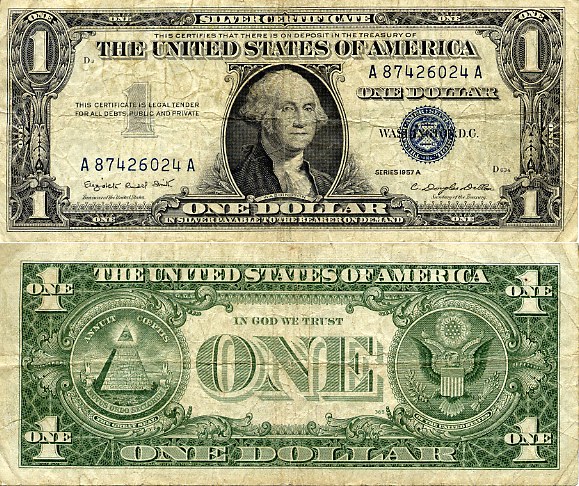For all the economic woes Americans have experienced this century, we’ve always been fed the idea that the U.S. dollar is the king of currency. And yet, the actual value of the dollar has been held down for years, to the point that a few years ago an American vacationing in Europe might have spent the equivalent of $7 or $8 on a cappuccino in Paris or a doughnut in Amsterdam. But for about a year now, the dollar has enjoyed a fairly steady rise—and it’s time for Americans to believe in the sustainable strength of U.S. currency.
This is not to suggest that there’s no chance growth in the dollar stalls out. But the current economic climate, both at home and abroad, suggests that Americans finally have some legitimate reasons to trust that the dollar’s value will continue to rise, or at least stabilize at a respectable level.
Here’s why.
History Suggests An Ongoing Rise In Value
It’s always a somewhat-dubious exercise to predict growth based on past charts and trends, because there are always factors that can arise relatively suddenly and have major impact on the market. That said, past periods of U.S. economic growth and dollar value increases have typically lasted for several years at a time, and on occasion, they have led to lengthy periods of stability.
Barron’s Online elaborated on the idea of using past economic cycles as prediction factors. They cited two periods of time—1980 to 1985, and 1995 to 2002—during which the dollar appreciated by 60 percent and 40 percent, respectively. “When the dollar appreciates,” the article noted, “it is typically part of a multiyear trend.” This history alone is intriguing for those hoping for a continued rise in the value of the dollar. It also makes some sense when, as the article also points out, the dollar is coming off of a multi-decade low, essentially meaning it has much further to go even to “normalize.”
The U.S. Economy Is Equipped To Sustain High Dollar Value
This is a statement that can be addressed from several different viewpoints. However, when you consider the U.S. in the context of the greater global economy, and specifically import/export markets, it is worth noting that rising currency values do not necessarily represent hurdles to continued growth. The basic idea that sometimes creates a conflict of interest between currency value and overall economic growth is that strong currency can hurt trade exports.
There is some evidence that this is less of a problem for the U.S. than some other countries because, as Fortune Magazine pointed out, “the U.S. is a fairly closed economy.” This is by no means true in a literal sense, as the definition of a closed economy is one that does not conduct import and export business with outside economies.
However, in the sense that “dollar movements have a fairly small impact on import prices and export activity,” Fortune makes a fair point. In part because much of the world expects to deal with a strong dollar. Also, because the U.S. conducts a great deal of overseas trade with American-based companies operating abroad, a strong dollar doesn’t necessarily have the logical effect on imports and exports. Considering this, it’s clear that trade interests should not function to naturally regulate or cap off U.S. dollar growth.
Europe’s Struggles Are Varied And Ongoing
The euro has held a firm advantage over the dollar for the past decade and has become one of the most influential currencies in the world. In fact, despite only being introduced in 1999, the euro is already the second leading currency in circulation, behind only the dollar. With this sort of circulation and the generally expected economic competency in most of Europe, the dollar has spent most of the past 10 years playing catch-up.
And yet, thanks in part to the strengthening of the U.S. economy, the euro is now experiencing struggles that are almost unprecedented in its history. Last year, political turmoil was cited as one of the leading causes of the euro’s decline, as situations like the conflict between Russia and Ukraine can lead to currency devaluation. With that situation having stabilized somewhat, it’s now the Greek debt crisis that’s causing instability for Europe. Investors and financial experts have had a difficult time agreeing on how increased Greek borrowing (or a Greek exit from the euro) may affect the currency’s value. But as Greek and European officials debate the next steps, uncertainty is already reversing some of the gains the euro made over the summer. This ongoing struggle strengthens the dollar.
Recent Fed Decisions Didn’t Hurt Much
In a Bloomberg Business article this past summer, it was correctly pointed out that “when Federal Reserve policy makers reduced their outlook for the path of interest rates, they may have also lowered trajectory for the dollar.” Indeed, an interest rate hike, which many expected to hear announced by the Fed this past June, would have been good news in the short-term for the dollar.
Despite its pessimistic title, the article goes on to conclude that “the dollar will probably trade in a range and then climb when the Fed eventually raises rates.” The dollar dropped off only moderately in the wake of the Fed’s decision to hold off on raising rates, and the implication here is that prices will remain somewhat stable in the time between now and a seemingly inevitable rate hike.



